Serving 1,169 students in grades 10-12, Muhlenberg High School ranks in the top 50% of all schools in Pennsylvania for overall test scores (math proficiency is top 30%, and reading proficiency is top 30%).
The percentage of students achieving proficiency in math is 55-59% (which is higher than the Pennsylvania state average of 36%). The percentage of students achieving proficiency in reading/language arts is 51% (which is lower than the Pennsylvania state average of 55%).
The student:teacher ratio of 18:1 is higher than the Pennsylvania state level of 13:1.
Minority enrollment is 72% of the student body (majority Hispanic), which is higher than the Pennsylvania state average of 39% (majority Hispanic).
Quick Stats (2025)
- Grades: 10-12
- Enrollment: 1,169 students
- Student:Teacher Ratio: 18:1
- Minority Enrollment: 72%
- Graduation Rate: 92% (Top 50% in PA)
- Overall Testing Rank: Top 50%
- Math Proficiency: 55-59% (Top 30%)
- Reading Proficiency: 51% (Btm 50%)
- Science Proficiency: ≤10% (Btm 50%)
- Source: National Center for Education Statistics (NCES), PA Dept. of Education
School Overview
Muhlenberg High School's student population of 1,169 students has grown by 28% over five school years.
The teacher population of 66 teachers has grown by 6% over five school years.
Grades Offered
Grades 10-12
Total Students
1,169 students
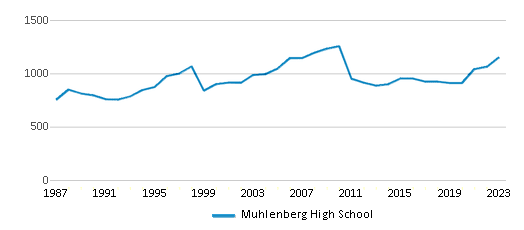
Gender %
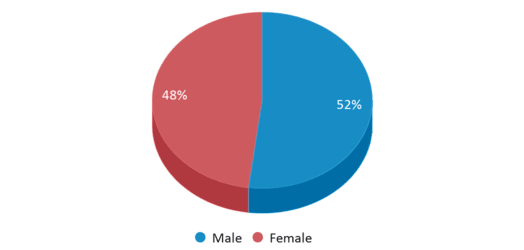
Total Classroom Teachers
66 teachers
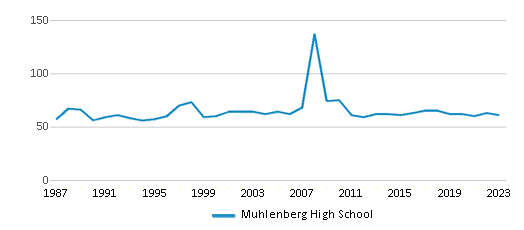
Students by Grade
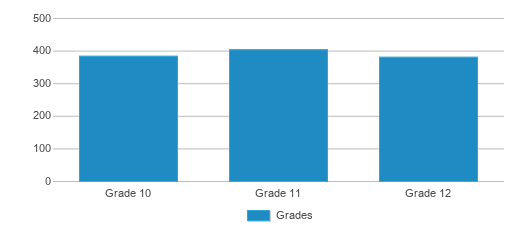
School Rankings
Muhlenberg High School ranks within the top 50% of all 2,733 schools in Pennsylvania (based off of combined math and reading proficiency testing data).
The diversity score of Muhlenberg High School is 0.54, which is less than the diversity score at state average of 0.59. The school's diversity has stayed relatively flat over five school years.
Overall Testing Rank
#1221 out of 2733 schools
(Top 50%)
(Top 50%)
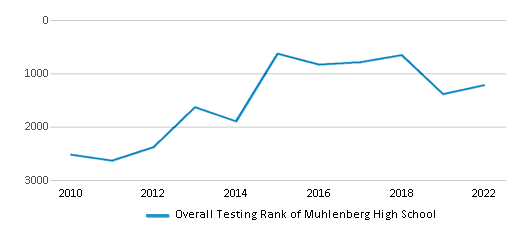
Math Test Scores (% Proficient)
55-59%
36%
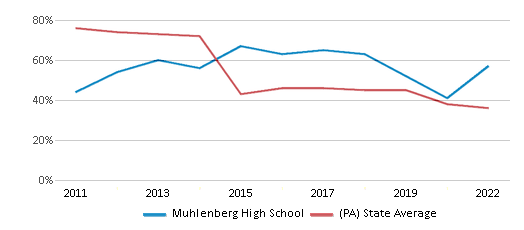
Reading/Language Arts Test Scores (% Proficient)
51%
55%

Science Test Scores (% Proficient)
≤10%
57%
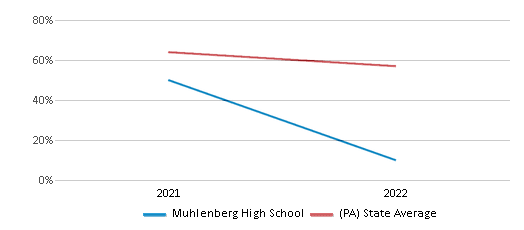
Student : Teacher Ratio
18:1
13:1
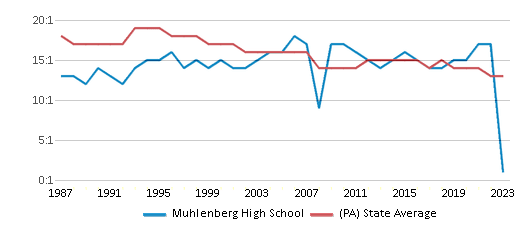
American Indian
n/a
n/a
Asian
1%
5%
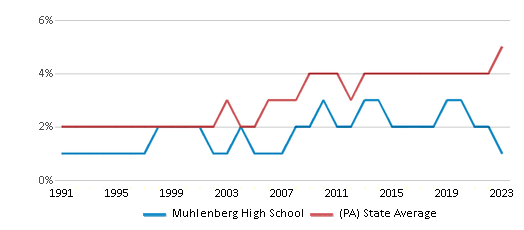
Hispanic
62%
15%
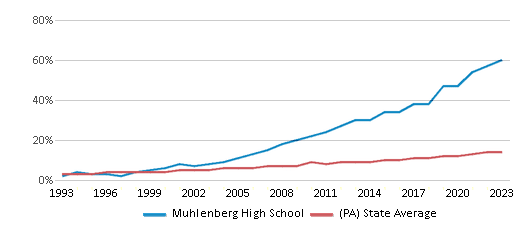
Black
7%
14%
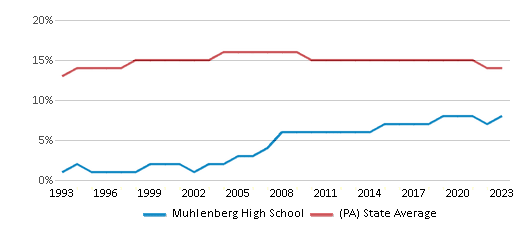
White
28%
61%

Hawaiian
n/a
n/a
Two or more races
2%
5%
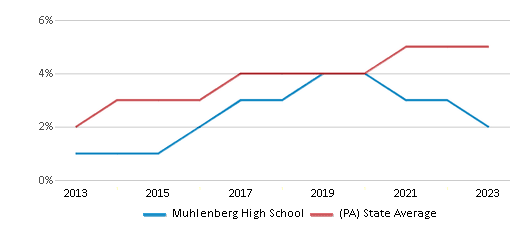
All Ethnic Groups
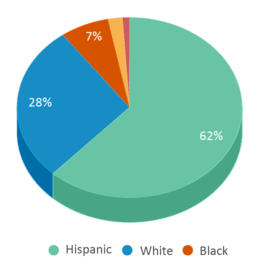
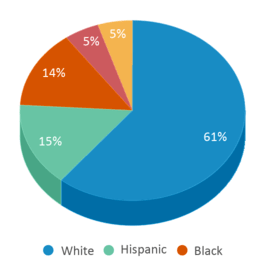
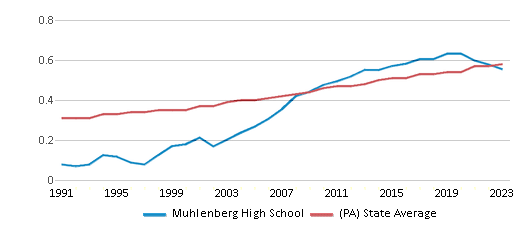
Graduation Rate
92%
87%
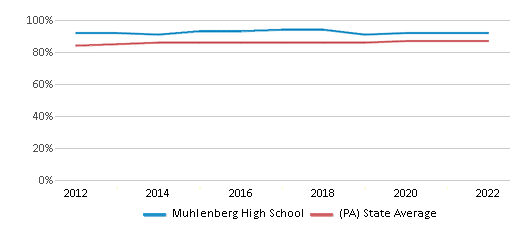
Eligible for Free Lunch
100%
60%
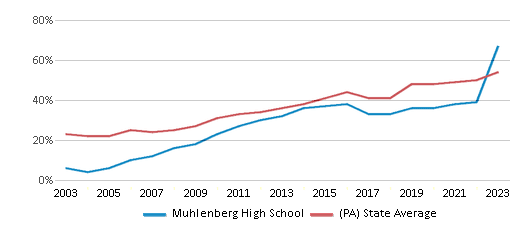
Eligible for Reduced Lunch (21-22)
3%
1%

School Statewide Testing
School District Name
Source: National Center for Education Statistics (NCES), PA Dept. of Education
Profile last updated: 02/09/2025
Frequently Asked Questions
What is Muhlenberg High School's ranking?
Muhlenberg High School is ranked #1221 out of 2,733 schools, which ranks it among the top 50% of public schools in Pennsylvania.
What schools are Muhlenberg High School often compared to?
Muhlenberg High Schoolis often viewed alongside schools like Wilson High School, Reading Sr. High School by visitors of our site.
What percent of students have achieved state testing proficiency in math and reading?
55-59% of students have achieved math proficiency (compared to the 36% PA state average), while 51% of students have achieved reading proficiency (compared to the 55% PA state average).
What is the graduation rate of Muhlenberg High School?
The graduation rate of Muhlenberg High School is 92%, which is higher than the Pennsylvania state average of 87%.
How many students attend Muhlenberg High School?
1,169 students attend Muhlenberg High School.
What is the racial composition of the student body?
62% of Muhlenberg High School students are Hispanic, 28% of students are White, 7% of students are Black, 2% of students are Two or more races, and 1% of students are Asian.
What is the student:teacher ratio of Muhlenberg High School?
Muhlenberg High School has a student ration of 18:1, which is higher than the Pennsylvania state average of 13:1.
What grades does Muhlenberg High School offer ?
Muhlenberg High School offers enrollment in grades 10-12
What school district is Muhlenberg High School part of?
Muhlenberg High School is part of Muhlenberg School District.
School Reviews
2 8/20/2019
I graduated in 72 and it seems like it was a totally different century from today... The makeup of the student body, the quality of the education.
4 9/20/2018
When my child was in elementary school (now in middle school), I thought it was a great school. I have not been pleased the past 2 years with the elementary school administrators and some of the teachers. The middle school and Intermediate school seem well so far. It's becoming a big school, lots of diversity for children to engage with others. I feel the only down fall is-they do not appear to support outside agencies to come into the school to support students. They claim their staff is well trained.... maybe they are however teachers have a different degree than a Behavioral Specialist or Counselor.
Review Muhlenberg High School. Reviews should be a few sentences in length. Please include any comments on:
- Quality of academic programs, teachers, and facilities
- Availability of music, art, sports and other extracurricular activities
Recent Articles

What Is A Charter School?
Explore the world of charter schools in this comprehensive guide. Learn about their history, how they operate, and the pros and cons of this educational innovation. Discover key facts about charter schools, including admission policies, demographics, and funding, as well as what to look for when considering a charter school for your child.

10 Reasons Why High School Sports Benefit Students
Discover the 10 compelling reasons why high school sports are beneficial for students. This comprehensive article explores how athletics enhance academic performance, foster personal growth, and develop crucial life skills. From improved fitness and time management to leadership development and community representation, learn why participating in high school sports can be a game-changer for students' overall success and well-being.

February 05, 2025
Understanding the U.S. Department of Education: Structure, Impact, and EvolutionWe explore how the Department of Education shapes American education, from its cabinet-level leadership to its impact on millions of students, written for general audiences seeking clarity on this vital institution.









